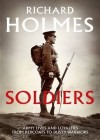Written by: Richard Holmes
HarperPress, London, 2011,
ISBN 9780007225699, 506 pp
Reviewed by: Major Tim Inglis
The Chief of Army has stressed the importance of all serving personnel knowing their military history. Our Army Museums, barracks and messes are filled with reminders of the proud history we have carved out of the events of the last century. Cleary our history reaches back much further through our links with the British Army, and it is this history that comes to life in Soldiers. Written around a series of themes, Soldiers explores the British Army over its 400-or-so year history. It is not a conventional military history.
The last acts of a dying man tell you a lot about his character. Richard Holmes—military historian, Territorial Army officer, academic, author and broadcaster—chose to finish this pen portrait of the British soldier as his parting shot. Drawing on an encyclopaedic range of sources, Holmes provides a platform for the soldiers he cared so much for, both as academic historian and as serving officer. His analysis is characteristically deep and the book rich in verbatim evidence. His pithy comments on turning points in military history provide a series of snapshots that form a backdrop to the central theme of this work on the life of the ordinary soldier. Fine words, carefully crafted by a master wordsmith at the peak of his game should not strain the reader’s patience. The narrative travels swiftly from witness to witness, seasoned with a soldier’s raw honesty and plain language.
In his first major theme, Holmes explores the relationship between the State and the Army. His chapter on the evolution of the rank system (Brass and Tapes) opens with ‘Armies are hierarchies, their structure given daily prominence by costume jewellery and codes of behaviour’. In this valuable essay on the steps that mark a soldier’s progress from private or trooper to field marshal, he cites the unusual case of ‘Wully’ Robertson, the only British soldier to climb the rank ladder from end to end.
The second main theme is leadership. In ‘Temporary Gentlemen; 1914–45’, he documents the emergency measures Britain took to raise a land army for two successive wars of national survival, taking a well-aimed shot at the widely held but inaccurate view that rank was rigidly class-based during the First World War. Reflecting on the evidence for class bias, Holmes shows how the abolition of commission purchase had the opposite effect to the purpose of well-intentioned army reforms.
Holmes’s third major theme is the recruitment of a national army. In his chapter entitled ‘Foreign Friends’, Australian readers will be happy with his assessment of the Australian Imperial Force contingent on the Western Front along with the Canadians that ‘contained, by common consent, some of the very best troops in the Allied armies’. He goes on to deal with the thorny issue of conflicting chains of command, citing the disagreement between General Auchinleck and Lieutenant General Morshead over splitting Morshead’s division.
In the author’s fourth major theme, the life of the regiment (‘Tribes and Totems’), we see his passions come close to the surface. ‘Tribal markings’ is an instructive account of the rise and fall of regimental colours, under which so much blood was bravely spilled. A poignant single sentence stands out, in light of recent experience: ‘Both colours of the 66th Foot were lost at Maiwand in Afghanistan in 1880, and neither has ever been recovered’.
In his last major theme, Holmes writes on the army as a social environment. Writing in the tone of a regimental Colonel, he pulls no punches. For example, ‘Bullies and Beast-masters’ deals with the thorny issue of impromptu discipline: ‘. beasting in its many forms is so deeply embedded in the gnarled load-bearing timbers where officers’ mess, sergeants’ mess and barrack room meet that it is part of the tribe’s fundamental structure. It is neither always good nor always bad’.
Page notes, endnotes and a thorough index will make Soldiers a useful source for future scholars. My only disappointment with Soldiers is that there cannot, will not, be a sequel. It seems appropriate that, having left hospital several times in order to finish one last book, Richard Holmes should have the final word. Here in Holmes’s words is his author’s intent: ‘This is not a chronological history of the army and its achievements. Its organisation is thematic rather than chronological, and its preoccupation not with big battles or frontier scrimmages, but with the myriad routine observances of military life. It is the story of a man as ancient as a redcoat in Charles II’s Tangier garrison and as modern as the gate guard on Camp Bastion’.

